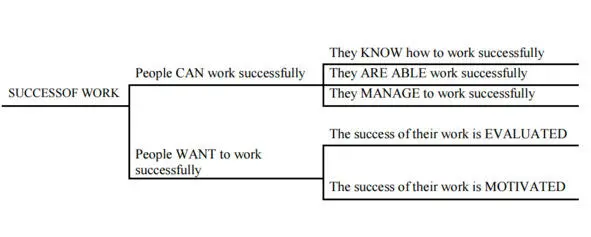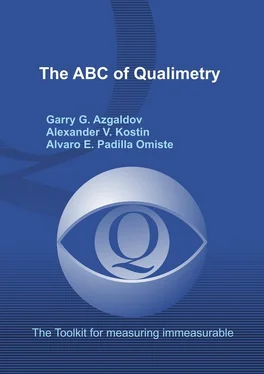Quantification is steadily broadening its scope of application, as evidenced by the growth of scientific disciplines or technical problem solving techniques that include the Greek μετρεω in their name. Here are a few examples:
Absorptiometry; autometry; autorefractometry; adaptometry; axiometry; actinometry; algometry; amperometry; angiostereometry; anthropometry; astrocalorimetry; astrometry; astrophotometry; audiometry; acidimetry; batimetry; biometry; bibliometry; veloergometry; visometry; viscosimetry; gigrometry; hygrometry; hydrometry; glucometry; gravimetry; gradiometry; densitometry; didactometry; dilatometry; dynamometry; dielectrometry; dosimetry; dopleometry; isometrym impedancemetry; inclinometry; interferometry; cliometrics; calipometry; calorimetry; chelatometry; conductometry; craniometry; coulometry; lipometry; luxmetry; mediometry; mercurimetry; morphometry; scientometrics; nitritometry; optometry; ordometry; oscillometry; optometry; perimetry; pirometry; pH-metry; planimetry; polarimetry; psychometrics; potentiometry; pulseoxymetry; radiometry; radiothermometry; redoxmetry; roentgenometry; refractometry; sensitometry; sociometry; spectrometry; spectroradiometry; spectropolariometry; spectrophotometry; spirometry; spiroergometry; stabilometry; stereometry; sphincterometry; tacheometry; tensometry; technometry; tonometry; turbidemetry; uroflowmetry; fluorimetry; photogrammetry; photocolorimetry; photometry; chronometry; equilibriometry; econometrics; exponometry; electrometry; echobiometry. Qualimetry is also a member of this steadily expanding family. (It would be wrong, however, to believe that every discipline using quantification has metry / metrics in its name.)
Qualimetry: A Tool for Enhancing the Efficiency of Any Kind of Work
What happened for the qualimetry to appear in the 1960s?
Modern management science has formulated five necessary and sufficient conditions for the success of any work, which can be represented by a “condition tree” (Figure 1).

Figure 1. Necessary and sufficient conditions for the success of any work
Four of these conditions, TO KNOW, TO BE ABLE, TO MANAGE, and TO MOTIVATE, are relatively easy to meet technically; regulatory documents for respective calculations are already in place. For example, every productive industry uses its own rate setter’s handbook (or a similar document), which is used to calculate the workforce and the time and tools needed to perform a piece of work (TO MANAGE condition). Other documents, like wage rate books, specify the requirements to be met in selecting the workforce to do some work successfully (TO BE ABLE condition).It is relatively easy to secure the TO KNOW condition: you only need to set the work executors a task. Finally, to meet the TO MOTIVATE condition all businesspersons or managers have a broad range of stimulatory actions they can use on their subordinates: material or moral; positive (“carrot”) or negative (“stick”); individualized or team-directed; one-off or time-phased, etc.
The TO EVALUATE condition is a very different case. What we evaluate is work. Any work (and its output) is characterized by three parameters: quantity, cost and quality. Arguably, the numerical evaluation of the quantity and cost parameters does not present any essential difficulties to most occupations in the real sector.
We have a different situation with the quality parameter. Here two aspects must be taken into account: the quality of individual labour and the quality of teamwork. As for individual labour, evaluating is just a trivial task (particularly if it is to be done in a quantitative form and with due regard for the many characteristics that constitute its quality).
Evaluating even the simple labour of an industrial worker poses difficulties: it is by no means always that it can be evaluated using a simple reject rate index. These difficulties multiply when it is a matter of quantitative assessment of the quality of complex labour, e.g., brainwork.
Here is an example to illustrate the importance and complexity of this task. Back in the early 1970s a group of UNESCO experts surveyed 1200 research teams in Austria, Belgium, Finland, Hungary and Sweden. Their conclusion: the most vexed problem in raising working efficiency in science is the lack of a reliable methodology for assessing the quality of work of individual researchers and research teams. (Similar examples can be cited with respect of managers, health professionals, engineers, teachers, administrators, and some others.).
Let us now look at the issue of assessment of the quality of teamwork. It stands to reason that the quality of output is its most important characteristic. As already mentioned, the outcome of any teamwork is, a product, a service, some information or energy. Of these four the product is by far the most complex in terms of the quality assessment method and the most important in terms of the breadth of its existence domain, given that more than twenty million kinds of products are manufactured by developed economies over the world.
It all goes to show that:
1. In the present-day context, successful, i.e. effective, productive work is a key condition of the economic health of both an individual company and a country at large.
2. When we address the problem of increasing the success/efficiency of any labour the key element is the quantitative assessment— both of the process and the outcome of labour; primarily its product.
3. Of the three characteristics of labour (and its outcome) – quantity, quality and cost – quality is the most complex one in terms of quantitative assessment.
4. Until quite recently, the approach to the problem of quantitative assessment of quality (primarily of products) lacked sound methodological support. At best, isolated quality quantification techniques were created, which had not any sound and unified rationale to support them. As a result, different quantifications of the quality of the same object could be worlds apart if calculated by different methods.
5. A natural corollary to propositions 1—4: in the early post-WWII years every industrialised country felt the need for scientific rationalisation of methods of quantitative assessment of the quality of production work and its outcomes.
6. It was F. Engels who noted that when a technical need appears in society, it pushes science forward faster than a dozen universities. The origins of qualimetry can be seen as a natural response to a pressing need for generalisation and perfection of the techniques of quantitative assessment of quality.
1.1.3.2. History of Qualimetry: From Aristotle to Our Times
Theoretical Reason for the Relatively Late Origin of Qualimetry
One may ask: why did qualimetry appear as an independent scientific discipline in the 1960s and not before?
There were two principal reasons.
The first, which we will tentatively call “theoretical”, is as follows. The term quality has existed in science for as much as 2500 years, since the days of Aristotle. His usage of the term referred to different concepts. (For convenience, hereafter the respective definitions for these concepts will be given a modern interpretation, in a concise form, which are more familiar and comprehensible than Aristotle’s definitions. – Auth. ). Subsequently, it was depending on its interpretation that it was decided whether or not it was necessary and possible to quantify/estimate this concept.
Interpretation I : Quality is an essential certainty of an object (i.e., a thing, phenomenon or process), which makes it what it is and not something else . In other words, quality is the kind of certainty that distinguishes, say, a human from a horse or a table.
Читать дальше













